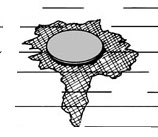Correcting Common Paint Problems

Here are tips and suggestions on how to correct common paint problems. Homeowners all over the country experience these types of problems. Take the time to read the instructions carefully and follow them and you can correct many of the paint problems around your home.
Stained Spots From Rusting Nail Heads
- Nail heads can rust and create spots on painted surfaces in your home. This problem is caused by using uncoated steel nails where excessive moisture exists under the paint (see image). The uncoated steel nails obviously cannot be removed, but you can correct the moisture problem.
- Try to locate the source of excessive moisture. Check for leakage from the eaves, evaporation from nearby plumbing pipes or sweating caused by heat from a bathroom or kitchen. If you can locate the source of moisture, try eliminating the problem by shutting off the condensation that causes the moisture.
- Remove any stained paint around all nail heads by sanding the area or using a wire brush. Sand clear down to the nail head, then sand the nail head itself to remove the built-up rust.
- Use a nail punch to countersink all nail heads approximately 1/8′ below the wood surface.
- Apply one even layer of undercoat over the countersunk nail and the area around it.
- After the area is primed, fill the countersunk hole with a good grade of caulking compound. Allow the compound to dry, then apply one coat of a good grade of outside house paint. After adequate drying time, apply a second coat. Use these steps to correct the problem.
Peeling Paint Under the Overhang of a Roof
- Paint sometimes peels under the overhang of a roof or in other areas of your home that are protected from weather. Such peeling is usually caused by a build-up of ‘salt’ deposits, which are normally washed away by rain in exposed areas.
- Your first step is to remove the peeling paint by sanding the surface thoroughly.
- After sanding, prepare a solution using a cleaner that leaves no film such as trisodium phosphate and water. Wash the sanded surface with this solution. Rinse the area with clear water and allow it to dry.
- After the surface has dried completely, apply two coats of a good grade of undercoating paint.
- When the undercoat has thoroughly dried, apply a coat of a top-quality house paint. Under some conditions, two finish coats may be required. This treatment should correct the peeling problem.
For home improvement advice, visit JS West Lumber & Ace Hardware Sonora, Ca. or visit www.acehardware.com and click on the Answers@Ace icon. Answers@Ace is an online resource with information for do-it-yourselfers about hardware and home improvement projects. The Everyday Projects section has pictures and detailed, step-by-step instructions for this and many more home improvement projects.
To speak to an Ace Hardware advisor in Sonora call: 209 532 7446.
